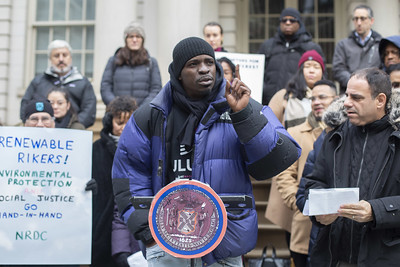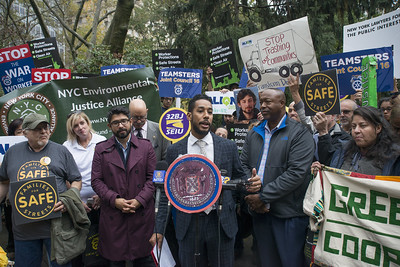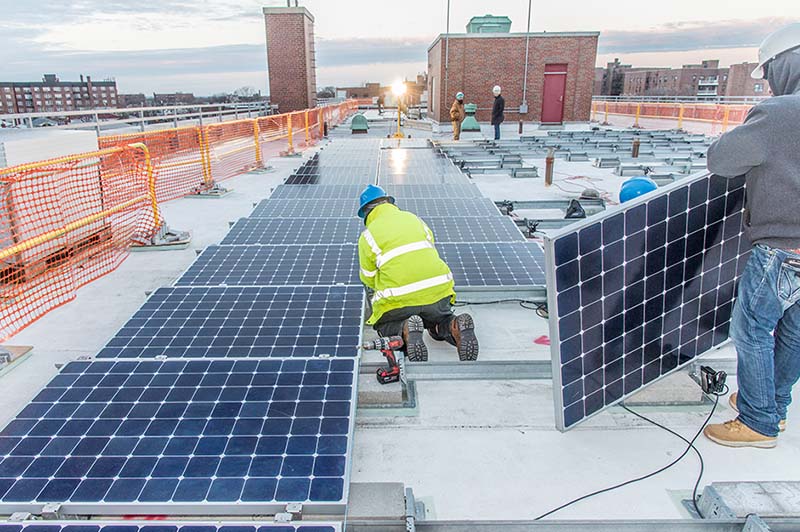The Climate Crisis
Climate change is a global problem that impacts all of us. We have already seen its effects around the world, and right here in New York City: horrific fires in Australia and California; deadly heat waves across Europe; the catastrophic hurricanes that have wreaked havoc on our neighbors in Puerto Rico and the Caribbean; and Superstorm Sandy, which caused 43 deaths and $19 billion in damage in the five boroughs alone.
We must act now and take aggressive measures to adapt to and mitigate climate change. The science is indisputable – if we don’t make changes now to reduce greenhouse gas emissions and halt global warming, our planet will suffer long-standing and irreversible effects.
Unfortunately, our federal government denies science and is callously looking to roll back important environmental protections nationwide. Not only is the Trump Administration postponing the U.S. Army Corps of Engineers study of coastal storm protections for New York and New Jersey, but the president of this country is also advising us to get out our “mops and buckets” rather than taking this problem seriously and helping us prepare for the future. The protection of our coastline is vital, and any delay in the study’s completion puts millions of lives at risk.
While we will continue to fight the federal government to combat damaging policies, New York City must continue to move forward with a local blueprint to address climate change. Already, we have taken bold action.
We passed groundbreaking legislation ensuring that sustainability is a core principle of government operations, reducing building emissions, and developing a streets master plan that focuses on safe, sustainable modes of transportation.
New York City also remains committed to the principles of the Paris Agreement, and we have joined together with other cities and countries in a global effort to reduce greenhouse gas emissions 80% by 2050.
We will continue to do more.
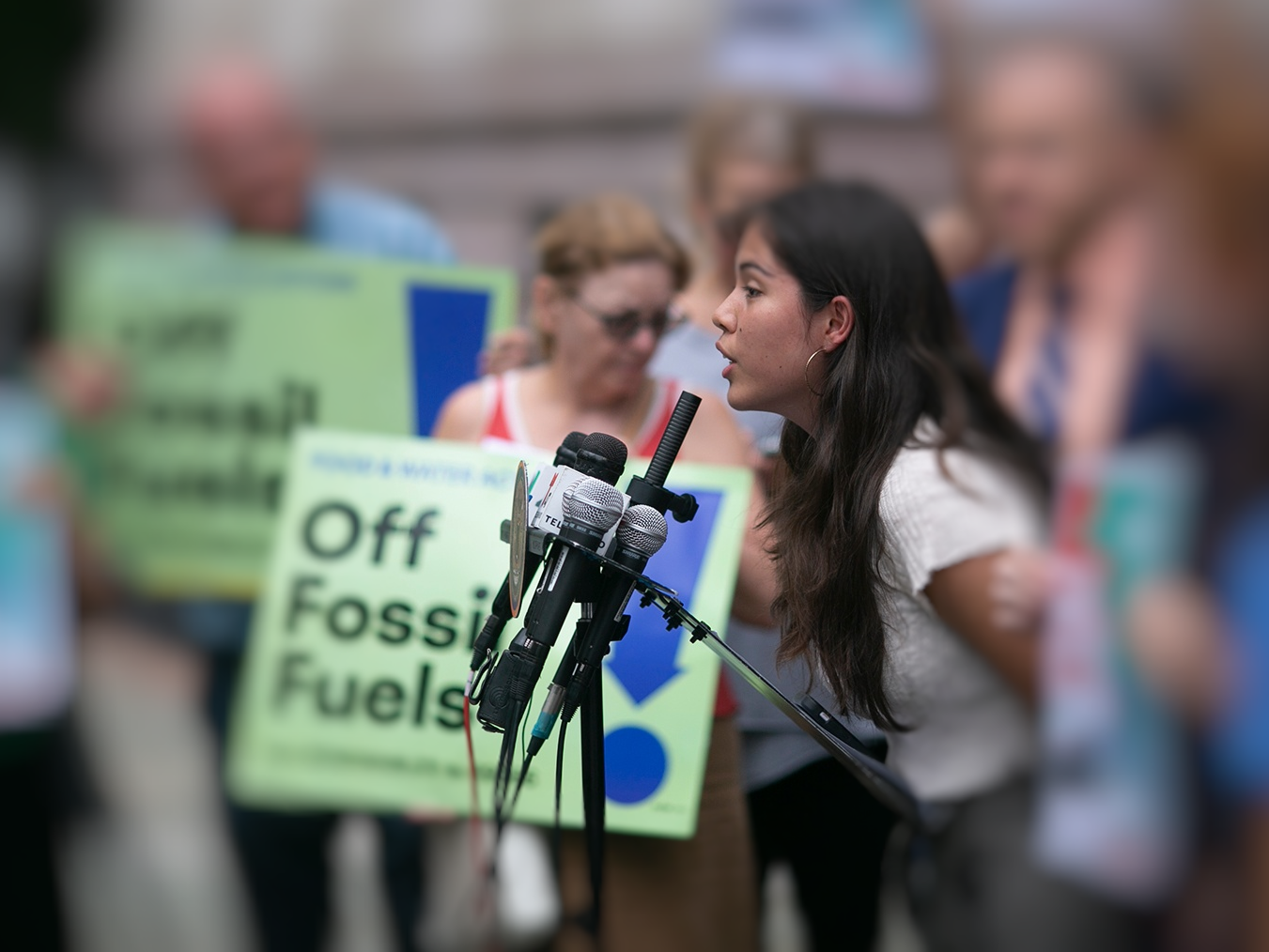
We need to build a more resilient city to withstand the rising sea level and extreme weather that is coming, and to protect both the neighborhoods that have already been hit hard and those that are at risk in the future. We need to transition from fossil fuels to clean, renewable energy. We need to transform ourselves into a circular economy, by designing waste out of our system. And we need to focus our efforts on building a robust pipeline for good paying green jobs.
This report lays out strategies that New York City can pursue in the fight against climate change. New York City is and always has been a leader. The actions we take together will inspire communities across the world, and help us usher in a greener, healthier, and more equitable future for our City and our planet.
Read Report
Read Press Release
Join the Conversation #BigGreenApple
Summary of Recommendations
The policy proposals outlined in this report are steps the City can take to fight the climate crisis.
Energy and Emissions
The city must reduce GHG emissions and move toward a clean energy economy.
Circular Economy
The City must reduce waste and pollution through increasing recycling and innovative design.
Green Jobs Pipeline
The City must foster the growth of good paying, sustainable jobs.


Resiliency
One major threat comes from the surrounding water. The city has approximately 520 miles of coastline – more shoreline mileage than the cities of Miami, Boston, Los Angeles, and San Francisco, combined. This makes the city vulnerable to the impacts of sea level rise, including: regular tidal flooding, coastal storm surges, and land inundation Moderate projections suggest the city could face monthly tidal flooding of some areas by the 2050s.
Climate change is also expected to cause increased precipitation. Localized flooding already regularly occurs during rainfalls in which the local stormwater management system becomes overwhelmed, or poorly-maintained systems become clogged. There are neighborhoods where residents report that street flooding from downpour water alone has become “a new normal” after any rainstorm.
The average daily maximum summer temperature in New York City has been rising since 1900 and it is projected that future heat waves will be longer, hotter, and more frequent. Extreme heat results in more deaths annually than any other type of extreme weather event and is exacerbated by the urban heat island effect, which can cause cities to be up to 22 degrees warmer than nearby suburban and rural fareas.
Below is a map of heat disparity in New York City. This map, made using Landsat 8 Satellite data, captures surface temperature. It shows how trees, water, elevation, and permeable surfaces such as grass decrease temperatures across the city. Black tar roofs, pavement, and a lack of tree coverage result in higher temperatures. Parks across the city are among the coolest locales, while JFK, Southeast Queens and the Bronx are among the hottest areas.
Resiliency is about preparedness. It is about strengthening our most socially and physically vulnerable infrastructure and neighborhoods. We can make New York City more resilient to climate change’s hazards through thoughtful planning that is grounded in science, while engaging our communities in the process.
Temperatures in NYC
Visualizing Heat Distribution in NYC, in Deviations from Mean Temperature
Resiliency Proposals
- Develop a Five-Borough Coastal Resiliency Plan
- Call on the Federal Government to Continue the New York/New Jersey Harbor and Tributaries Study
- Call on the Federal Government to Pro-Actively Fund Resiliency
- Increase the Resiliency of New Construction
- Revitalize FloodHelpNY
- Call for a Tri-State Regional Commission
Achieve Cooling Equity
- Develop a Comprehensive Cooling Plan
- Increase Cooling Assistance for Vulnerable Populations
- Ensure Building-Specific Cooling Centers
- Better Measure Heat-Related Deaths
Increase Green Infrastructure
- Expand Green Infrastructure in the MS4 Area to Reduce Flooding
- Fill Every Tree Pit
- Create Sustainable Playgrounds
- Create Green Ends
- Green Bus Stops
- Initiate a Comprehensive Sustainable Pavement Testing Program
- Reduce Impervious Areas on New Development Projects
- Increase the Amount of Reclaimed Asphalt
Cool the Public Realm
- Increase the Use of Cool Roofs
- Use Public Shade Structures
Plan for the Future
- Consider Climate Change in Capital Planning
- Utilize the Climate Resiliency Design Guidelines
- Conduct Vulnerability Assessments for Critical City Infrastructure and Buildings
- Improve the Collection of Real-Time Local Climate Data
Build Present Day Resiliency
- Increase Funding for the Office of Long-Term Planning and Sustainability
- Designate Chief Resiliency Officers
- Develop Civic Engagement for Sustainability Projects in Every Community District
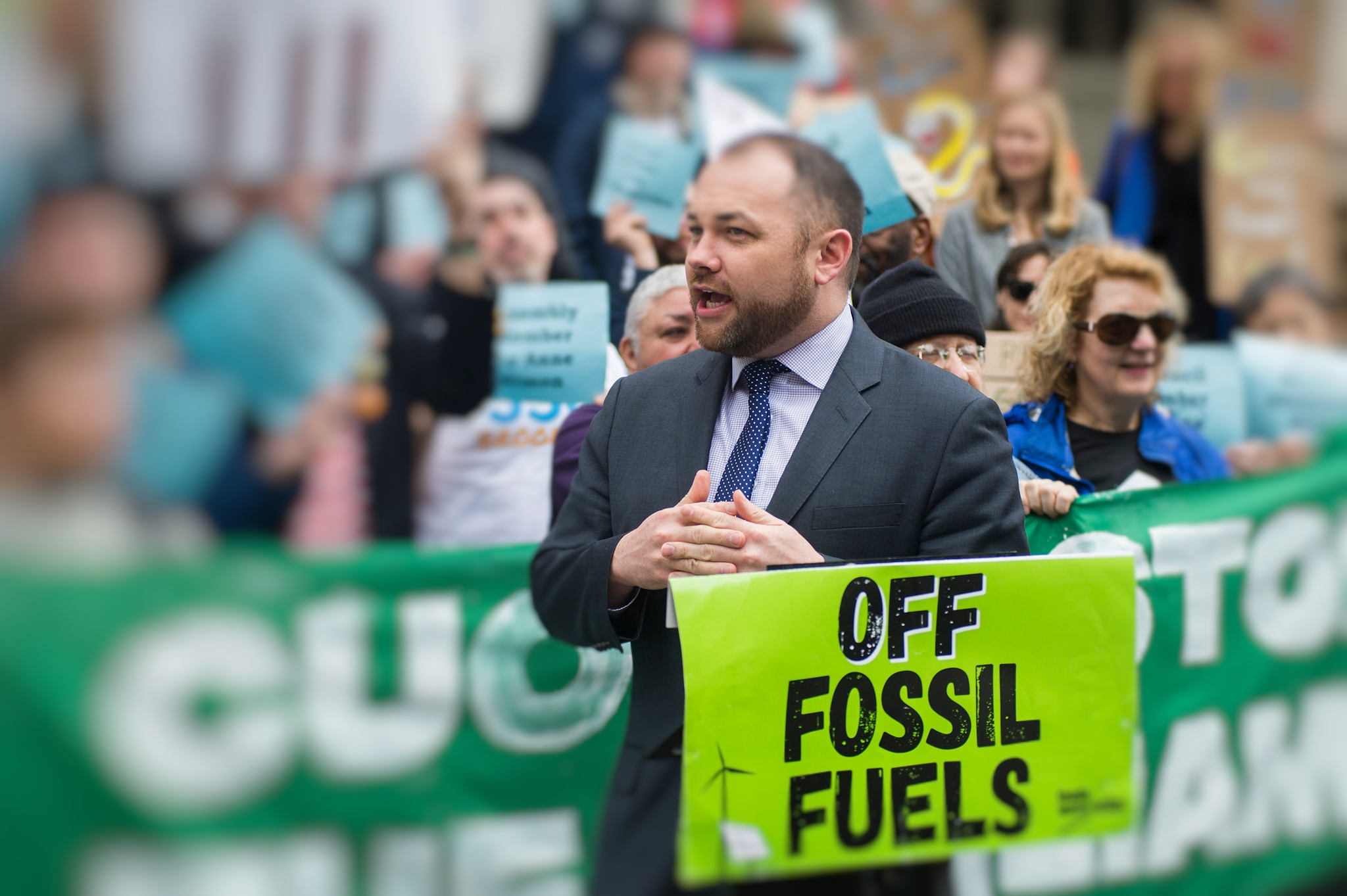
Energy and Emissions
Much of our climate emergency comes from energy systems. Among other global leaders, New York State and City are working to reduce GHG emissions by over 80% by 2050 to help avoid the most drastic effects of climate change. The State goal is an emissions reduction of 85% from a 1990 baseline by 2050 (85×50) and the City goal is 80% from a 2005 baseline by 2050 (80×50). The only way to accomplish this is to aggressively transition off of fossil fuels and onto clean, renewable energy.
The transition from fossil fuels to renewable energy creates challenges to operating power grids and energy systems to meet the energy needs required to handle base, intermediate, and peak loads. The power created by renewable energy generation is intermittent, as wind can blow at a variety of speeds and cloud variation alters the feed to solar photovoltaic systems. Safeguarding grid stability requires a diverse mix of electrical sources. Renewable electricity sources such as hydropower and geothermal power can easily imitate traditional coal-fired or nuclear power, and geothermal power is most efficient when it is allowed to run continuously and without interruptions. Power sources that are flexible, reliable, and able to ramp up are essential to creating a network that is dependable given the cost and bandwidth to operate such a grid.
According to the U.S. Energy Information Administration, the five main sources of renewable energy are biomass, geothermal, hydropower, solar, and wind. Together, these energies have thus far grown to comprise 14% of New York State and 7% of New York City energy consumption as of 2017 (see figures). As of 2017, fossil fuels are used to create 65% of the energy source for NYC.
Energy by Source, 2017
Fossil Fuels
Nuclear Hydropower
Renewables Other
NYC Mayor’s Office of Sustainability, Energy Information Administration: State Energy Data System
Energy and Emissions Proposals
- Work with the State to Get the Transmission Capacity Needed to Bring Clean Energy to New York City
- Call on Con Edison to Invest in Grid Infrastructure in order to Eliminate Fossil Fuels from NYC’s Energy Grid by 2050
- Call on State to Increase Oversight of Con Edison
- Revive and Repurpose the City’s Public Utility
- Transform Rikers Island into a Renewable Energy Hub
- Enable a District-Scale Geothermal System
- Create a Database of Subsurface Conditions to Support Better Engineering of Geothermal Heat Pumps
- Develop an Affordable Housing Renewable Energy Project
- Establish a District-Scale Clean Energy Project
- Review Regulatory Barriers to Battery Storage
Reduce Buildings Emissions
- Require Buildings to be Electrification-Ready
- Benchmark Buildings at 10,000 Square Feet
- Create a “Greening your Neighborhood” Program
- Reduce Emissions While Creating and Preserving Green, Affordable Housing
Improve Indoor Air Quality
- Ensure Building HVAC Maintenance
- Create an Online Dashboard for Community Air Quality and Monitoring Initiatives
- Use Materials and Construction Techniques that Improve Indoor Air Quality
Reduce City Transportation Emissions
- Achieve a 100% Zero Emissions Vehicle School Bus Fleet by 2040
- Reconsider Zoning Requirements for Parking, Zero Emission Vehicles, and Car Shares
- Expand Bike Share Programs
- Increase Bike Parking
- Call on New York State to adopt a Low-Carbon Fuel Standard
- Call on the Federal Government to Increase Fuel Economy Standards
- Call on the Federal Government to Strengthen Emission Standards
- Call on the Federal Government to Prioritize Public Transit and Other Sustainable Modes in Federal Transportation Funding
Improve Electric Vehicle Infrastructure
- Expand the Availability of Electric Vehicle Chargers
- Call on the Public Service Commission to Adopt an Order that would Require the Utilities to Contribute to Electric Vehicle Infrastructure Costs for Parking Lots
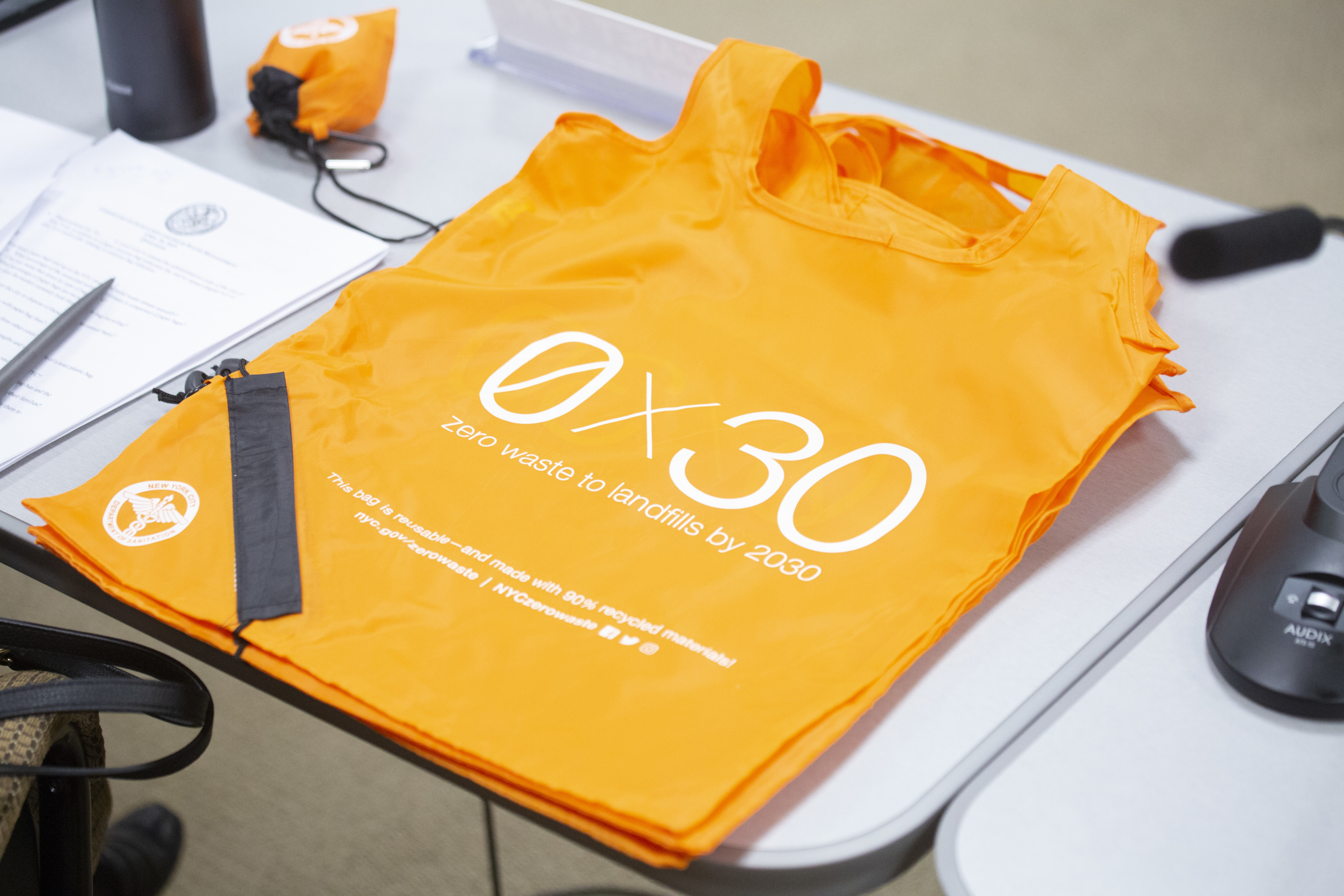
Sustainable, Circular Economy
To achieve a circular economy, we must reduce the amount of waste we create, reuse or recycle what we are unable to reduce, and support growth of the market for products and services that are designed to significantly reduce negative impacts on the environment.
The standard approach to production has typically been: take, make, use, and dispose. Raw materials—often generated through resource-intense and high-impact processes—are transformed into products, which are purchased by consumers who ultimately throw them out. This linear consumption model is not sustainable.
To be successful, the City must have a clear understanding of the materials people use and how these materials are reused or disposed of. Collecting appropriate data and accurately analyzing our waste stream is an essential part of this process, as it allows us to identify inefficiencies and find opportunities for innovation and change.
Of the 80% of NYC Waste that went to landfill in 2017, 77% of it can be diverted. Of the 50 community board districts in NYC, 23 districts (40%) have full coverage, no enrollment needed, curbside organics pickup available.
Potential for Landfill Diversion
NYC’s Residential Waste Composition
DSNY Monthly Tonnage Data, 2017 NYC Residential, School, and NYCHA Waste Characterization Study
*Other: Items that currently have no or limited options for beneficial reuse
Curbside Composting
Community Districts that Participate in Organics Collection
Sustainable, Circular Economy Goals
Increase Access to and Confidence in Recycling
- Ensure Data-Driven Progress Toward Zero Waste
- Track Commercial Recyclables
- Mandate Citywide Curbside Organics Separation and Collection
- Beneficially Reuse Organics End Material from Anaerobic Digesters
- Study Bioplastics for Optimal Waste Management
- Create Extended Producer Responsibility for Mattresses
Divert Textile Waste from Landfill for Reuse and Recycling
- Divert All Household Textile Waste from Landfill
- Expand RefashionNYC to All Eligible Buildings
- Recycle or Reuse All Commercial Textile Waste
- Create Textile Sorting and Storage Facilities
Increase City Support for Sustainable Businesses and Jobs
- Partner to Hold Roundtables on Sustainable Businesses
- Support Sustainable Small Businesses
- Local Industry Focus: NYC’s Sustainable Fashion Industry
Extend the Life of Building Materials
- Recycle Construction and Demolition Materials
- Create a Building Material Database
- Pilot a Lifecycle Analysis of Construction Projects
- Increase the Use of Recyclable Carpet
Reduce Waste
- Reduce Single-Use Plastics
- Reduce Junk Mail
- Implement a Conscious Consumerism Campaign
- Use a Trash Wheel to Clean the City’s Waterways

Green Jobs Pipeline
There are a number of private training programs available to New Yorkers that prepare participants with the necessary skills to work in a green job.
Through these initiatives, green job development opportunities have reached a wide audience; however, there is still a large proportion of the City’s existing and potential workforce that could benefit from these programs.
Difficulties in Hiring in the Green Sector, 2017
Goals to Drive a Green Economy
Build a Sustainable Workforce
- Focus Workforce Development on Green Jobs
- Facilitate a Conference on NYC Green Job Development
- Call for Offshore Wind Development Projects to Prioritize Green Jobs for Environmental Justice Communities
- Green Training and Certification for Home Improvement Contractors
Increase Work-Based Learning Programs that Focus on Green Jobs
- Create Additional CTE Programs Dedicated to Green Jobs
- Increase Green Job Focused Internships and Work-Based Learning Experiences for High School Students
Improve Access to Green STEM and Climate Change Education
- Expand Green STEM to All DOE Schools
- Expand Green STEM in After-School Programs
- Implement Climate Change Education in All New York Public Schools
Build Student Interest in Green Jobs
- Strategy: Increase Resources for Students Interested in Green Jobs

Our city needs to respond to the climate crisis and it needs to enable New Yorkers to do their part.
This report provides a local blueprint for the city to move forward to address climate change.
For feedback, comments, and questions please email DataInfo@council.nyc.gov.
Created by the NYC Council Data Team.

